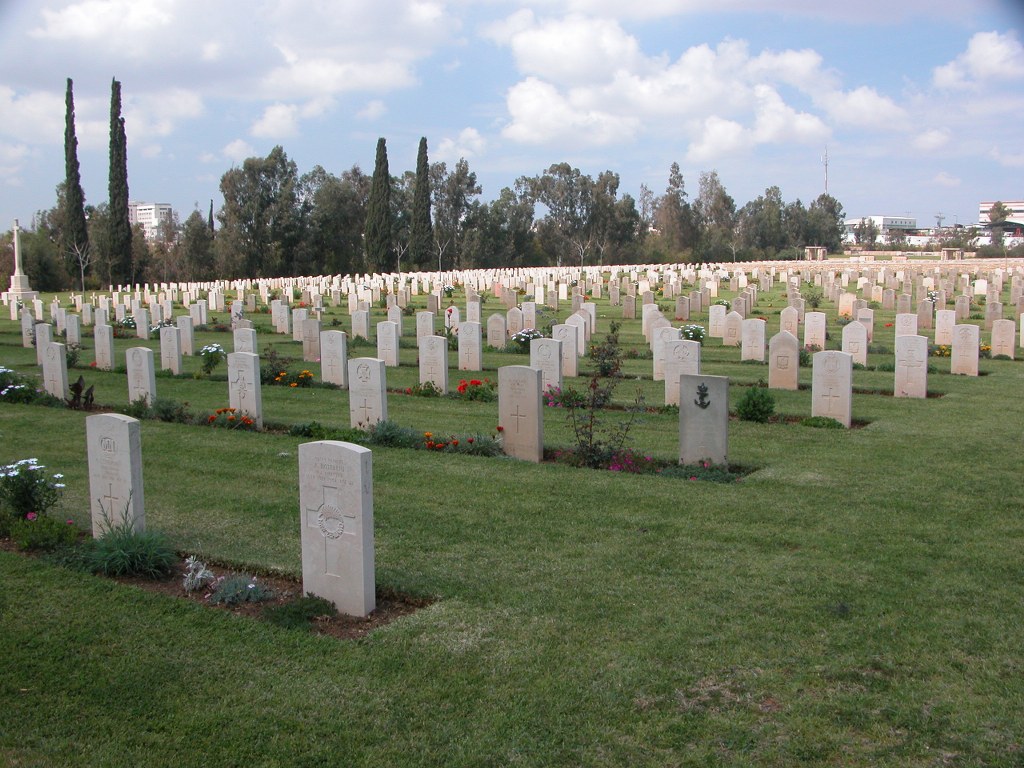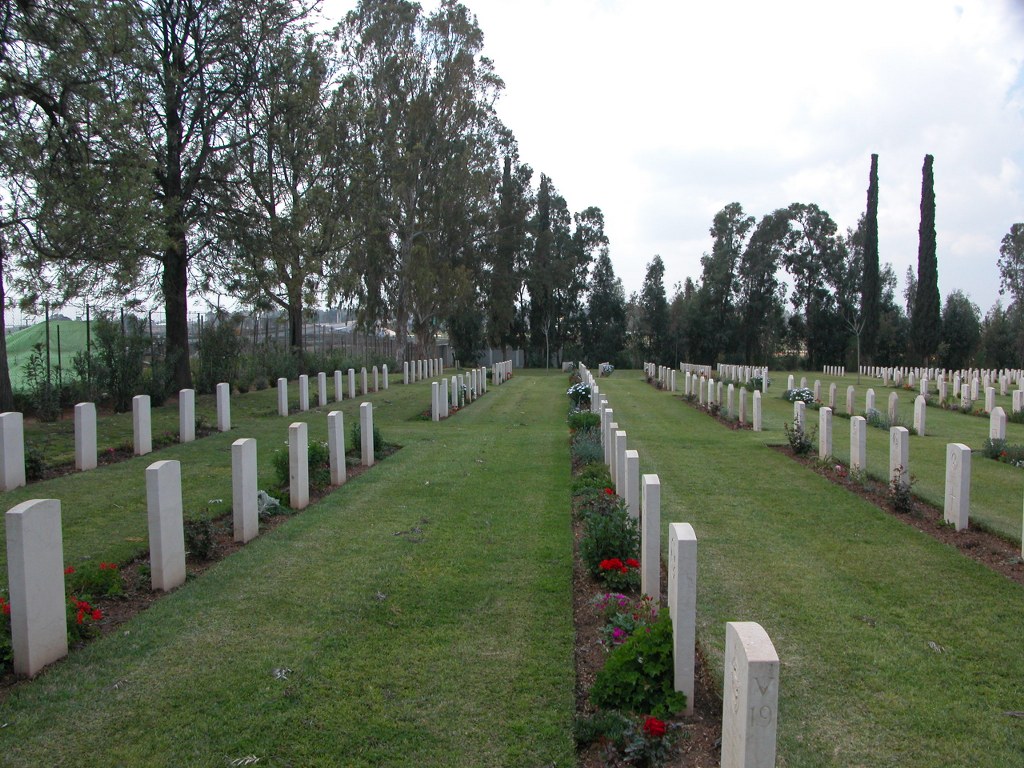Ramleh War Cemetery
- Country Israel and Palestine (including Gaza)
- Total identified casualties 3888 Find these casualties
- Identified casualties from First & Second World War
- GPS Coordinates Latitude: 31.93018, Longitude: 34.88383
Historical Note
 A total of 453 Indian and 62 Egyptian First World War casualties buried here were commemorated on collective nameless memorials, with their names listed in the printed cemetery register. In 2014 these names were added to the newly built Ramleh 1914-1918 Memorial.
A total of 453 Indian and 62 Egyptian First World War casualties buried here were commemorated on collective nameless memorials, with their names listed in the printed cemetery register. In 2014 these names were added to the newly built Ramleh 1914-1918 Memorial.
You can find more information about historical inequalities in commemoration in our Special Committee’s report.
Cemetery Spotlight - Ramleh War Cemetery
The Ramleh War Cemetery, located in Ramla, Israel, is the largest Commonwealth war cemetery in the country. It holds deep historical significance as a resting place for soldiers who died during World War I, World War II, and the British Mandate period in Palestine.

Ramleh War Cemetery is located in the city of Ramla, central Israel, approximately 20 km from Tel Aviv and 35 km from Jerusalem. It lies near the Ramla Prison and can be accessed via Route 44 and Route 434. It’s adjacent to the Ramla Military Cemetery and also houses the CWGC’s regional office for the Middle East.
Established in 1917 during World War I, the cemetery became a resting place for those who died during the British campaign in Palestine. Ramleh was a strategic location for medical units, with casualty clearing stations and hospitals treating the wounded from battles across the region. It later continued to serve during World War II.
Today, it holds over 5,800 graves, including:
• 3,300 World War I Commonwealth graves • 1,193 World War II graves
• Additional burials from various nationalities, including German, Indian, Polish, and Egyptian servicemen.
• Numerous soldiers from the Indian Army, including Sikhs, Muslims, and Hindus, reflecting the diversity of the Commonwealth forces.
• Neil Primrose, a British politician and soldier killed in WWI.
• Mervyn Paice and Clifford Martin, British sergeants executed by the Irgun in 1947 in response to the execution of three Irgun members by the British authorities.
Many graves belong to men who died of illness rather than in combat, highlighting the brutal conditions of wartime logistics and medical care. The mix of Christian, Jewish, Muslim, and Hindu graves—each marked appropriately according to tradition—speaks volumes about the global and multicultural contributions to the war efforts.
Our team undertakes regular grass cutting, irrigation monitoring, border planting, headstone cleaning, weed control, and inspections of structural elements like the Cross of Sacrifice and boundary walls. Given the scale of the site, this is a full-time, year-round effort.

Due to the Mediterranean climate, we use seasonal planting plans and have adapted to water-saving technologies. We mulch flower beds to retain moisture and utilise local soil amendments to promote plant health.

The cemetery faces some significant climate extremes, particularly intense summer heat with temperatures regularly exceeding 40°C. To address this, the CWGC employs smart irrigation systems, moisture sensors and resilient planting strategies that help maintain the site's greenery and the integrity of the headstones.

Moreover, chemical use is deliberately kept to a minimum by prioritising organic gardening methods and manual weeding, thus maintaining the ecological balance of the cemetery's landscape.
Additionally, urban development around the cemetery requires careful coordination with local authorities to ensure that nearby construction or land-use changes do not adversely affect the site's condition or accessibility.
Although issues with security and vandalism are extremely rare, the CWGC maintains strong relationships with the local community to preserve the cemetery's safety and dignity.
Location information
From Tel Aviv, take road number one (Ayalon) south towards Jerusalem. Leave at the exit signposted Lod/Ramleh. This is the exit after Ben Gurion Airport. Proceed along Route 40 for approximately 5 kilometres. At the traffic lights signposted Lod (South) turn right. At the roundabout turn left. The Cemetery entrance is on the left, after 400 metres.
Visiting information
The Cemetery is open from 08:30am to 15:00pm Monday to Friday. Closed weekends and Public Holidays.
Visits outside of these hours can be arranged by calling the Regional Office on +972 (0)8 9221220.
Wheelchair access to the cemetery is possible via the main entrance.
PLEASE NOTE : The 1914-1918 section has many grave references identical to the 1939-1945 and Post War sections. Please check you are in the correct part of the cemetery by a simple check of the dates on the headstones. The cemetery layout plan is available online at www.cwgc.org
History information
The cemetery dates from the First World War, when Ramleh (now Ramla) was occupied by the 1st Australian Light Horse Brigade on 1 November 1917. Field Ambulances, and later Casualty Clearing Stations, were posted at Ramleh and Lydda from December 1917 onwards. The cemetery was begun by the medical units, but some graves were brought in later from the battlefields and from Latron, Sarona and Wilhema Military and Indian Cemeteries.
During the Second World War, this cemetery was used by the Ramla Royal Air Force Station and by various Commonwealth hospitals posted in turn to the area for varying periods.
RAMLEH WAR CEMETERY contains 3,300 Commonwealth burials of the First World War, 964 of them unidentified. Second World War burials number 1,168. There are also 892 war graves of other nationalities from both wars, and 525 non-war burials, many from the RAF and garrison stations that were at Ramleh in the inter war years and until the end of the British Mandate in Palestine in 1948.
Within Ramleh War Cemetery will be found:
The RAMLEH 1914-18 MEMORIAL, erected in 1961 to commemorate more than 300 Commonwealth, German and Turkish servicemen of the First World War who lie buried in cemeteries elsewhere in Israel where their graves could no longer be maintained. Only 74 of the casualties are named.
The RAMLEH 1939-45 MEMORIAL, commemorating 28 servicemen and women of various units from the Second World War, and six non-war casualties of the Palestine Police Force, who lie buried in cemeteries elsewhere in Israel where their graves could not be maintained in perpetuity.
The original war cemetery was designed by Sir John J. Burnet, but following the addition of the 1939-45 war graves, the site was extensively remodelled in the 1950s by Alan Stewart, ARIBA.







